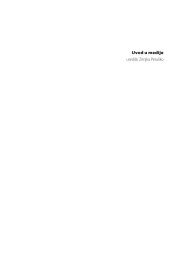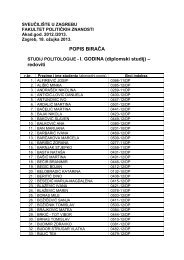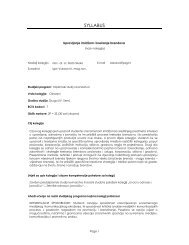SYLLABUS - FPZG
SYLLABUS - FPZG
SYLLABUS - FPZG
You also want an ePaper? Increase the reach of your titles
YUMPU automatically turns print PDFs into web optimized ePapers that Google loves.
<strong>SYLLABUS</strong><br />
Media and the city<br />
Nositelj kolegija dr. sc. Zlatan Krajina E-mail zlatan.krajina@googlemail.com<br />
Studijski program: Diplomski<br />
Vrsta kolegija: Izborni<br />
Godina studija: Druga<br />
ECTS bodovi: 7<br />
Oblik nastave: 2 + 2<br />
Cilj kolegija<br />
Media and the city have always been implicated in each other as structures and practices, as<br />
well as strategies and tactics, of communication within and across socially organised space.<br />
Media have always been utilised in the tension between the urban planners’ efforts to control<br />
space by drawing coherent maps from macro vantage points, and the subversive<br />
fragmentary realities lived at the micro-level of mobile pedestrians. In fact, to say that most of<br />
the world population now lives in cities, actually means that they live in spaces managed and<br />
negotiated through the use of communication technologies situated in the specific contexts of<br />
(post)modern urban heterogeneity. Media technologies are not only located in, but also form<br />
part of the infrastructures of public space. Urban screens occupy space, but also represent<br />
other spaces. Modern city is a media city – mediation defines urban space we live in.<br />
At first, in the early 20th century, it was the varying angles, perspectives and montage of<br />
photography and films, and, more recently, it is the data circulation through technologies such<br />
as geospatially responsive mobile phones, personal laptops, digital surveillance and large<br />
scale urban screens that planners and pedestrians use to make sense of the permanently<br />
growing and changing urban space. Rather than merely suggesting that the city is mediated<br />
anew in the spirit of the increasingly popular notion of ‘abundance of information and<br />
mediation’, this course offers a range of views of the contemporary city as re-mediated along<br />
much older spatial vectors of continuity and change.<br />
In what is a developing field in media and cultural studies, the concoction “media city” is<br />
increasingly the focus of debates, which cannot satisfactorily examine the dual object of study<br />
from a single field, but require specialised inputs from a range of fields (such as urban<br />
sociology, sociology of everyday life, sociology of media consumption, computing studies,<br />
Page 1
urban studies, architecture, and critical theory). Adopting this inter-disciplinary frame, in this<br />
course we examine how contemporary urban spaces manifest themselves as “media cities”,<br />
and why we can most usefully understand a wide array of forms of media communications in<br />
the particular, urban context. The course is divided into two key parts, adopting Michel de<br />
Certeau’s seminal dichotomy between institutional strategies of organising space and<br />
pedestrian tactics of resisting the institutional arrangements of everyday environments. The first<br />
part of the course will examine forms of the former (strategies of designing, promoting and<br />
imagining the city as a photographic and filmic city; the creation of so-called ‘virtual cities’ by<br />
virtue of connecting transnationally positioned urban electronic informational nodes; outdoor<br />
advertising; urban screens and architectural media facades), while the second part of the<br />
course will examine cases of the latter (the flâneur, extended media audiences, community<br />
media, mobile phone, IPod and walkman users, public art with practices of graffiti and posters,<br />
habituation of mediated public spaces).<br />
Uvjeti za upis predmeta i ulazne kompetencije potrebne za predmet<br />
Excellent command of academic English.<br />
Ishodi učenja na razini studijskog programa kojima kolegij pridonosi<br />
By the end of the course students will:<br />
• become familiar with some of the key concepts surrounding the emergences of the<br />
modern city and the post-modern metropolis, and the processes of (re)mediation<br />
• be able to identify and choose an appropriate conceptual methodology to analyse a<br />
case of how cities are technologically mediated, and how urban mediation informs<br />
the senses of time and space<br />
• develop a historicised, multi-level and inter-disciplinary understanding of interactions<br />
with media and urban space<br />
Očekivani ishodi učenja na razini kolegija (4-10 ishoda učenja)<br />
By the end of the course students will be able to:<br />
• engage in an independent informed exploration of a particular practical case and a<br />
conceptual domain relevant to understanding urban mediations and mediated cities<br />
• undertake research of a multidimensional conceptual and methodological design,<br />
and to report on that research within the time constraints, and in the required<br />
standards of quality and form<br />
• feel comfortable about transgressing traditional (often unproductive) boundaries<br />
between scholarly disciplines and to think inter-disciplinarily<br />
• identify connections between, and the potential for synthesis of, micro and macro<br />
levels of enquiry in examining particular cases<br />
• generously historicise the popular presentation, actual usage, and implications in<br />
particular cultures and societies, of the present developments in spatial design and<br />
technological innovations, and identify what might be new developments therein<br />
work individually and in groups, and make use of a diverse range of academic and<br />
non-academic resources (libraries, electronic sources, public sites, archives, etc.)<br />
Page 2
Sadržaj kolegija detaljno razrađen prema satnici nastave<br />
TJEDAN TEMA<br />
1. susret Introduction: Defining the Media City<br />
2. susret<br />
Key Approaches to the study of media and the city: the spatiality of a<br />
mediated urban space<br />
3. susret The Cinematic and Photographic City<br />
4. susret Exploring Urban Screens<br />
5. susret Outdoor Advertising and Urban Consumption<br />
6. susret Easter – no lectures (preparations for coursework)<br />
7. susret Urban Branding and Regeneration<br />
8. susret Myths and realities of a 'virtual' city<br />
9. susret<br />
Key Approaches to the study of urban subjects and mediated urban<br />
experience<br />
10. susret Negotiating the City: Personal stereo and mobile phones uses<br />
11. susret Media, Community and the City<br />
12. susret The subversive potentials of mediated public art<br />
13. susret Habituating mediated urban space: the uses of existential geography<br />
14. susret<br />
Obveze studenata<br />
INvestigating the mediated city: Some methodological issues and concluding<br />
remarks<br />
Students are required to attend one-hour lectures, followed by one-hour small group seminars<br />
(the student qualifies for the examination by having between not more than four absences),<br />
and, in preparation for the seminar, to read the text(s) set for each week’s session (available in<br />
advance through the library and online learning resources) and to think of ways of engaging<br />
with those texts with reference to empirical cases of their choice, so as to discuss and examine<br />
the pertinent issues.<br />
Ocjenjivanje i vrjednovanje rada studenata tijekom nastave i na završnom ispitu<br />
In all aspects of work on this course, students will be encouraged to act creatively and critically<br />
in reflecting on the postmodern urban spaces they inhabit, drawing on arts, graffiti, films, music,<br />
public events, and other particular forms of mediations.<br />
Page 3
Students will be encouraged (but not obliged) to prepare, in advance of each week’s session,<br />
individual and/or group presentations of weekly readings thinking through the main points,<br />
their weaknesses and strengths, as well as examples useful in an examination of the text.<br />
Students are invited to refer to cases identified in (as well as own produced work in, where<br />
appropriate and applicable) photography, film, exhibition and everyday urban spaces.<br />
Students will be encouraged to embark on their own explorations of the city, its spaces,<br />
objects, and mediations, to critically reflect on their experiences of everyday life in a<br />
technologically mediated city, and to seek out most useful ways of understanding and<br />
researching issues arising from those explorations. In the middle of the term students will be<br />
asked to submit a 2000 word long coursework, answering the examined essay question, but<br />
with reference to only one of the approaches covered in the course so far. Students are<br />
encouraged to do so, especially because they will be allowed to use the same material in their<br />
final examined work, and can thus seek appropriate feedback well in advance of the final<br />
deadline. The examined essay should be written in an intelligible academic English and in an<br />
engaging way (intellectually, empirically and conceptually), in 4-5000 words (bibliography<br />
excluded). The examined essay question is: With reference to two theoretical approaches<br />
covered in the course, discuss a case of urban mediation, paying particular attention to<br />
institutions’ strategies and tactics of resistance involved. All three key elements of the question<br />
– one empirical case and two theoretical approaches (based on several key texts, by the<br />
student’s own choice, any from the reading list) – must be present in the essay for a minimum<br />
of a pass (grade 2). Other grades will vary depending on a) the intellectual rigour, depth and<br />
complexity demonstrated, b) the clarity, coherence and presentation of the text, and c) the<br />
appropriateness of the chosen theories and the example, and the effective mobilisation of the<br />
three elements in an independent and critical study. Students will have plenty of opportunity to<br />
prepare for the examination, by attending individual tutorials with the course leader and<br />
interacting with one another (see below).<br />
Obvezna literatura (dostupna u knjižnici i putem ostalih medija):<br />
• Couldry, N. and McCarthy, A. (eds.) MediaSpace: Place, Scale and Culture in a Media<br />
Age London and New York: Routledge<br />
• Eckardt, F. (2008) Mediacity: Situations, Practices and Encounters Frank & Timme.<br />
• McQuire, S. (2008) The Media City: Media, Architecture and Urban Space Los Angeles,<br />
London, New Delhi and Singapore: Sage Publications.<br />
• Gordon, E. (2010) The Urban Spectator: American Concept-Cities from Kodak to Google<br />
University Press of New England (Hanover and London).<br />
• Krajina, Z. (2009) ‘Exploring Urban Screens’ in Culture Unbound: Journal Of Current Cultural<br />
Research Vol 1<br />
Dopunska literatura:<br />
• LeGates, R. T. and Stout, F. (2000) The City Reader 2 nd edition Routledge. [a single most<br />
comprehensive reader to date on all matters of cities, urban space and urban sociology,<br />
parts will be useful to individual sessions throughout the course]<br />
• Miles, M. And Hall, T. (2004) City Cultures Reader 2 nd edition Routledge, parts 1 and 2<br />
• Lefebvre, H. (1996) Writings on Cities Oxford and Malden, MA: Blackwell Publishers.<br />
• Massey, D. (2005) For Space London, Thousand Oaks and New Delhi: Sage Publications.<br />
• Soja, E. (1989) Postmodern Geographies: The Reassertion of Space in Critical Social Theory<br />
Verso<br />
• Soja, E. (1996) Thirdspace: Journeys to Los Angeles and Other Real-and-Imagined<br />
Page 4
• Places. Oxford: Blackwell.<br />
• Soja, E. (2000) Postmetropolis: Critical Studies of Cities and Regions. Oxford:<br />
• Blackwell.<br />
• Massey, D. (2007) World City Cambridge and Malden, MA: Polity Press.<br />
• Massey, D. et al (eds) (1999) City Worlds Routledge (with Open University Press)<br />
• ag4 (2006) Media Facades Cologne, London and New York: daab.<br />
• Blau, E. and Rupnik, I. (2007) Project Zagreb: Transition as Condition, Strategy, Practice<br />
Harvard University: Actar A.<br />
• Kasinitz, P. (ed.) Metropolis: Center and Symbol of Our Times New York: New York University<br />
Press.<br />
• Betsky, A. et al. Scanning: The Aberrant Architectures of Dillard + Scofidio New York:<br />
Whitney Museum of American Art.<br />
• Augé, M. (1995) Non-places: Introduction to an Anthropology of Supermodernity London,<br />
New York: Verso.<br />
• Leach, N. (ed). Rethinking Architecture: A Reader in Cultural Theory London and New York:<br />
Routledge.<br />
• Benjamin, W. (1999) Illuminations London: Pimlico.<br />
• Berker, T. et al. (eds.) (2006) Domestication of Media and Technology Maidenhead and<br />
New York: Open University Press.<br />
• Berry, C. et al. (eds.) Electronic Elsewheres: Media, Technology, and the Experience of<br />
Social Space Minneapolis and London: University of Minnesota Press.<br />
• Borden, I., Kerr, J. et al (eds.) Unknown City: Contesting Architecture and Social Space MIT<br />
• Parker, S. (2004) Urban Theory and the Urban Experience: Encountering the City Routledge<br />
• Donald, J. (1995) 'The City, The Cinema: Modern Spaces' in Jenks, C. (ed) Visual Culture<br />
London and NY Routledge, pp. 77-95.<br />
• Aronczyk, M. (2006) 'Place as Brand: Lessons from Two Canadian Cities', Paper from the<br />
ESF-LiU Conference “Cities and Media: Cultural Perspectives on Urban Identities in a<br />
Mediatized World”, Vadstena 25–29 October 2006. (Available online at<br />
www.ep.liu.se/ecp/020/)<br />
• Ridell, S. (2010) 'The cybercity as a medium: Public living and agency in the digitally<br />
shaped urban space', in Nagenborg, Michael, Albrechtslund Anders, Klamt Martin and<br />
Murakami Wood David (eds) ICT & The City (special issue of International Review of<br />
Information Ethics) Vol. 12 pp. 11-19.<br />
• Morley, D. (2000) Home Territories: Media, mobility and identity London and New York:<br />
Routledge (excerpt – pp. 128-146, 149-170)<br />
• Gaved Mark and Mulholland Paul (2008) 'Pioneers, Subcultures and Cooperatives: the<br />
Grassroots Augmentation of Urban Places' in Aurigi, A Cindio G (2008) Augmented Urban<br />
Spaces: Articulating the Physical and Electronic City Ashgate, pp 172-184.<br />
• Miles, M. (1997) Art, Space and the City: Public art and urban futures<br />
• London: Routledge, pp 3-11<br />
• Bullivant, L. (2007) ‘Beyond the Kiosk and the Billboard’ in Architectural Design Special<br />
Issue: 4dsocial: Interactive Design Environments Volume 77, Issue 4, pages 14–23,<br />
July/August 2007<br />
• Sassen, S. (2008) ‘Reading the City in a Global Digital Age’ in McQuire et al (eds) Urban<br />
Screens Reader Amsterdam: Institute of Network Cultures.<br />
• Ward, J. (2004) 'Berlin, the Virtual Global City' in Journal of Visual Culture Vol 3(2): 239-256.<br />
• Bull, M. (2000) Sounding Out the City: Personal Stereos and the Management of Everyday<br />
Life Oxford: Berg.<br />
• Colomina, B. (1994) Privacy and Publicity: Architecture as Mass Media Cambridge, MA: MIT<br />
Press.<br />
• Castells, M. et al. (2007) Mobile Communication and Society: A Global Perspective<br />
Cambridge MA: MIT Press.<br />
• Gitlin, T. (2001) Media Unlimited: How the Torrent of Images and Sounds Overwhelms Our<br />
Lives Metropolitan Books: New York.<br />
Page 5
• Fuller, M. (2005) Media Ecologies: Materialist Energies in Art and Technoculture Cambridge,<br />
MA: MIT Press.<br />
• Frisby, D. (1985) Fragments of Modernity: Theories of Modernity in the Work of Simmel,<br />
Kracauer and Benjamin Cambridge: Polity Press and Oxford: Basil Blackwell.<br />
• de Certeau, M. (1984) The Practice of Everyday Life Berkley, Los Angeles and London:<br />
University of California Press.<br />
• Cronin, A. M. (2010) Advertising, Commercial Spaces and the Urban Basingstoke: Palgrave<br />
Macmillan.<br />
• Goffman, E. (1972) Relations in Public: Microstudies of the Public Order Harmondsworth:<br />
Penguin Books.<br />
• Kwon, M. (2004) One Place after Another: Site-Specific Art and Locational Identity<br />
Cambridge, MA and London: The MIT Press.<br />
• Lefebvre, H. (1991) The Production of Space Malden, MA and Oxford, UK: Blackwell.<br />
• Lynch, K. (1960) The Image of the City Cambridge, MA and London: MIT Press.<br />
• Massey, D. (1991) ‘A Global Sense of Place’ in Marxism Today June 1991, p. 24-29.<br />
• McCullough, M. (2004) Digital Ground: Architecture, Pervasive Computing, and<br />
Environmental Knowing Cambridge, MA: MIT Press.<br />
• Moores, S. (2003) ‘Media, Flows and Places’ in Media@LSE Electronic Working Papers<br />
• Mouffe, C. (2008) ‘Art and Democracy: Art as an Agonistic Intervention in Public Space’ in<br />
Art as Public Issue: How Art and Its Institutions Reinvent the Public Dimension (Open: Cahier<br />
on Art and the Public Domain 2008/No.14) Rotterdam: NAi Publishers, pp. 6-13.<br />
• Park, R. E. et al. (1968) The City Chicago and London: University of Chicago Press.<br />
• Venturi, R. et al. (1977) Learning From Las Vegas: The Forgotten Symbolism of Architectural<br />
Form Cambridge, MA and London: The MIT Press.<br />
• Virilio, P. (2004) ‘The Overexposed City’ in Redhead, S. (2004) (ed.) The Paul Virilio Reader<br />
Edinburgh: Edinburgh University Press, pp. 83-99.<br />
Načini praćenja kvalitete koji osiguravaju stjecanje izlaznih kompetencija<br />
In addition to preparing and giving short summary presentations week by week, emphasising<br />
some of the key issues in seminar texts, students will be encouraged to embark on their own<br />
explorations of the city to critically reflect on their experiences of everyday life in a<br />
technologically mediated city, and to seek out most useful ways of understanding issues arising<br />
from those explorations, especially in preparation of their examined essays. To assist this work,<br />
there will be a series of field lectures guest lecturers giving presentations on particular issues,<br />
such as the key Croatian public urban artwork (Ana Kutleša from Urban Festival), urban walks<br />
(taking a tour through regenerated spaces and squats in Zagreb, such as “Medika”, with the<br />
prominent writer on Zagreb Saša Šimpraga) and urban anthropology (by a key researcher in<br />
the field Valentina Gulin Zrnić from the Institute of Ethnology), and others. Students will be<br />
strongly encouraged to attend those sessions and interact with the guest lecturers and make<br />
links and try out their own prospective essay projects. There will be collaboration with the<br />
“Urban Festival” in Zagreb, where students will be invited to join the curators in the preparation<br />
of the festival and make use of that experience in their essays. In the middle of the term<br />
students will be encouraged to submit a 2000 word long coursework, answering the examined<br />
essay question, but with reference to only one of the approaches covered in the course so far,<br />
so as to seek appropriate feedback well in advance of the final deadline. The examined essay<br />
will be assessed depending on a) the intellectual rigour, depth and complexity demonstrated,<br />
b) the clarity, coherence and presentation of the text, and c) the appropriateness of the<br />
chosen theories and the example, and the effective mobilisation of the three elements in an<br />
independent and critical study. At the end of the course students will be encouraged to give<br />
Page 6
short presentations of the planned essays so as to acquire feedback from their peers in<br />
advance of the submission.<br />
Page 7











